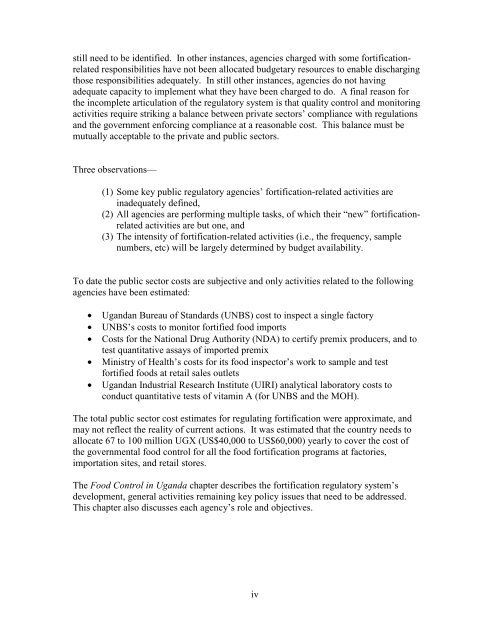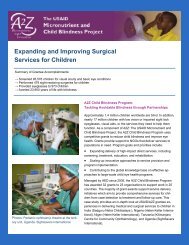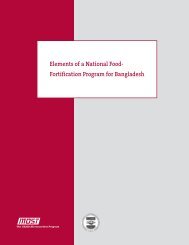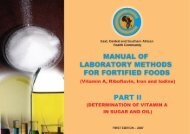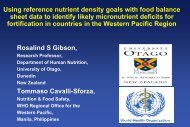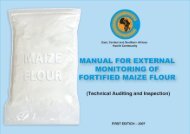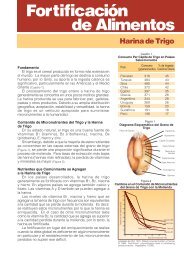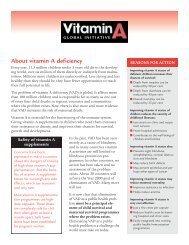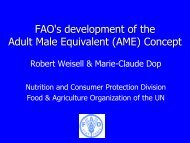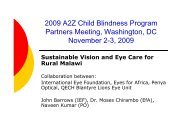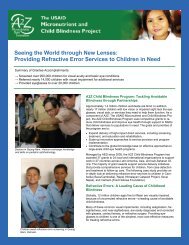Fortification of Vegetable oil and Sugar with Vitamin A in Uganda
Fortification of Vegetable oil and Sugar with Vitamin A in Uganda
Fortification of Vegetable oil and Sugar with Vitamin A in Uganda
You also want an ePaper? Increase the reach of your titles
YUMPU automatically turns print PDFs into web optimized ePapers that Google loves.
still need to be identified. In other <strong>in</strong>stances, agencies charged <strong>with</strong> some fortificationrelated<br />
responsibilities have not been allocated budgetary resources to enable discharg<strong>in</strong>g<br />
those responsibilities adequately. In still other <strong>in</strong>stances, agencies do not hav<strong>in</strong>g<br />
adequate capacity to implement what they have been charged to do. A f<strong>in</strong>al reason for<br />
the <strong>in</strong>complete articulation <strong>of</strong> the regulatory system is that quality control <strong>and</strong> monitor<strong>in</strong>g<br />
activities require strik<strong>in</strong>g a balance between private sectors’ compliance <strong>with</strong> regulations<br />
<strong>and</strong> the government enforc<strong>in</strong>g compliance at a reasonable cost. This balance must be<br />
mutually acceptable to the private <strong>and</strong> public sectors.<br />
Three observations—<br />
(1) Some key public regulatory agencies’ fortification-related activities are<br />
<strong>in</strong>adequately def<strong>in</strong>ed,<br />
(2) All agencies are perform<strong>in</strong>g multiple tasks, <strong>of</strong> which their “new” fortificationrelated<br />
activities are but one, <strong>and</strong><br />
(3) The <strong>in</strong>tensity <strong>of</strong> fortification-related activities (i.e., the frequency, sample<br />
numbers, etc) will be largely determ<strong>in</strong>ed by budget availability.<br />
To date the public sector costs are subjective <strong>and</strong> only activities related to the follow<strong>in</strong>g<br />
agencies have been estimated:<br />
• Ug<strong>and</strong>an Bureau <strong>of</strong> St<strong>and</strong>ards (UNBS) cost to <strong>in</strong>spect a s<strong>in</strong>gle factory<br />
• UNBS’s costs to monitor fortified food imports<br />
• Costs for the National Drug Authority (NDA) to certify premix producers, <strong>and</strong> to<br />
test quantitative assays <strong>of</strong> imported premix<br />
• M<strong>in</strong>istry <strong>of</strong> Health’s costs for its food <strong>in</strong>spector’s work to sample <strong>and</strong> test<br />
fortified foods at retail sales outlets<br />
• Ug<strong>and</strong>an Industrial Research Institute (UIRI) analytical laboratory costs to<br />
conduct quantitative tests <strong>of</strong> vitam<strong>in</strong> A (for UNBS <strong>and</strong> the MOH).<br />
The total public sector cost estimates for regulat<strong>in</strong>g fortification were approximate, <strong>and</strong><br />
may not reflect the reality <strong>of</strong> current actions. It was estimated that the country needs to<br />
allocate 67 to 100 million UGX (US$40,000 to US$60,000) yearly to cover the cost <strong>of</strong><br />
the governmental food control for all the food fortification programs at factories,<br />
importation sites, <strong>and</strong> retail stores.<br />
The Food Control <strong>in</strong> Ug<strong>and</strong>a chapter describes the fortification regulatory system’s<br />
development, general activities rema<strong>in</strong><strong>in</strong>g key policy issues that need to be addressed.<br />
This chapter also discusses each agency’s role <strong>and</strong> objectives.<br />
iv


